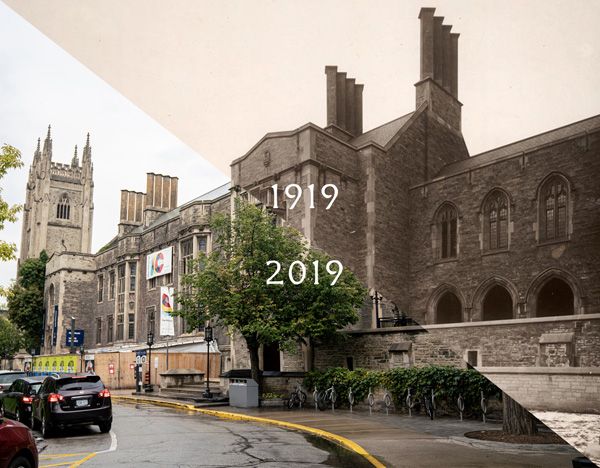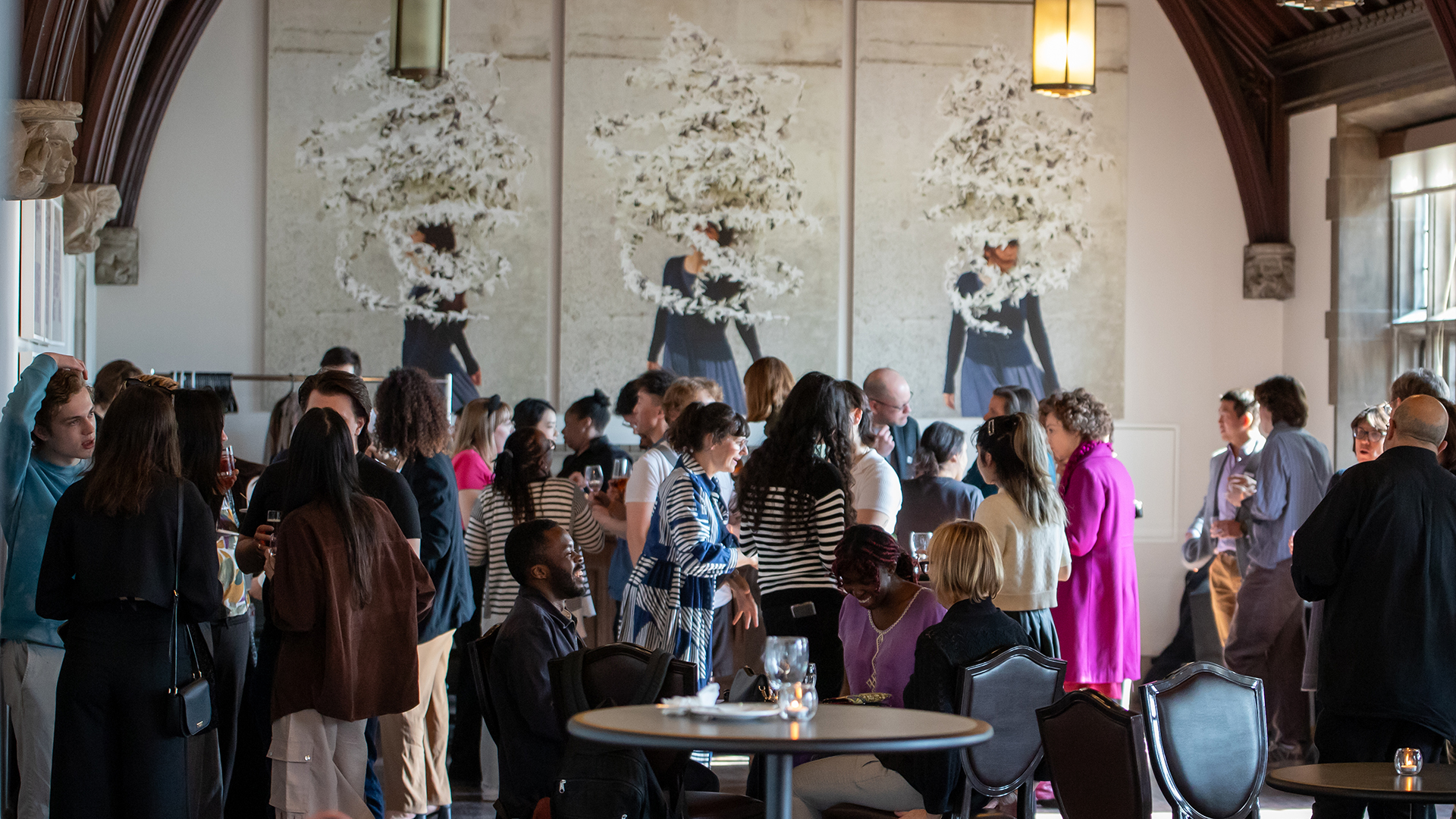The history of Hart House is inseparable from the memory of the two world wars. On this Remembrance Day, one like none other in recent memory, we remember the history of a building that continues to open its doors wide to students.
A Greatly Delayed Grand Opening
Hart House officially opened its doors to students on November 11, 1919, but this grand opening was many years in the making. Construction on Hart House began in 1911, but the outbreak of World War I in 1914 had a huge impact across the city and on the University of Toronto campus.
Rather than opening Hart House as a center for student life, as originally imagined, it was used during World War I for various initiatives to support the war effort and help prepare the thousands of students going abroad as soldiers.
One example of Hart House’s role during this time was to use its sub-basement as a space to prepare students for trench warfare. Hart House Theatre now stands where there was once a three-dimensional backdrop of a Belgian village painted by none other than Lawren Harris, a future member of the Group of Seven. This backdrop served as target practice for soldiers in training.

The tragedies of World War I were like none the world had ever seen before. As many as 20 million people were killed, and 21 million people were wounded*, including military and civilian deaths. During World War I, 628 members of the University of Toronto community died during active service. During these war years, as more soldiers returned home with extensive injuries, Hart House played another important role. There was a need for professionals that could administer rehabilitative care to care for these injured soldiers. So, part of Hart House was transformed into the temporary host to the Military School of Orthopedic Surgery and Physiotherapy in 1917. Over two years, 250 students completed the six-month course and were then assigned to help rehabilitate soldiers at military hospitals across the country. This school also had a long-term impact on the field of physiotherapy. Enid Gordon Graham came to the University of Toronto in 1917 to supervise the Massage and Treatment Department of the School. Her work was influential in shaping the national standard of physiotherapy education and practice in Canada that still exists to this day. Her massive contributions to Canadian healthcare were recognized by Canada’s Historic Sites and Monuments Board in 2017 with the unveiling of a plaque dedicated to her memory outside the north entrance of the Fitness Centre.

On November 11, 1919, one year after the end of World War I and on the first Armistice Day, Hart House was officially gifted to the University of Toronto. On that historic day, many special guests attended the building’s formal opening, including the Duke of Devonshire, the Mayor of Toronto, several University staff, and of course, Vincent Massey, the founder of Hart House and the Vice-Chairman of the Massey Foundation. At the opening ceremony, Vincent Massey shared his vision for Hart House to serve as a unifying force at the University and a space where students and the broader University community could enjoy “common life” and pursue “high endeavour” together outside the classroom. But the memory of the war years was a looming presence throughout the ceremony. Massey noted that “of those who passed through these schools there were many who, had they returned, would have enriched the life of this place.”
During the opening ceremony for Hart House, the Duke of Devonshire laid the cornerstone for Soldier’s Tower, the commemorative tower to be built next door. The tower was ultimately completed in 1924* and continues to stand as a monument to all those University of Toronto community members who have served in the military over the years.
Almost a decade after construction began, Hart House was open for the enjoyment of (male) students. The space became a living testament to both the memory of war and the potential of future generations to avoid the pitfalls of their predecessors.
A Remarkable Resurfaced Artifact
Hart House’s opening ceremony, 101 years ago, lives on in images and stories. Last year, on November 12, 2019, Hart House marked the anniversary of this grand opening with the Hart House Gala of the Century, complete with special guests, performances, and the reveal of a specially commissioned artwork by Rebecca Belmore and Osvaldo Yero entitled Waabidiziiyan doopwining (To see oneself at the table).
Only a few weeks ago, a new discovery brought the importance of this day back into focus. While combing through closets and organizing artifacts at Hart House, long-time staff member, Rick Palidwor came across a key like no other.

Stored with other important Hart House artifacts, the key came with a calligraphied note (pictured below) that explained its significance. It states: “This key was used by His Excellency The Duke of Devonshire Governor General Canada to open the East Door of Hart House, November 11th, 1919.”
This artifact, rediscovered a century after its initial use, is a reminder of the importance of that day in Hart House history. On that first Armistice Day, the University of Toronto community recognized the literal open door that stood before them.
Rick also found a programme from the 1919 event. It includes the Duke of Devonshire’s statement when he was given the key to open Hart House: “In view of the splendid part that you have played in the war it is most appropriate that this ceremony should take place on the first anniversary of the signing of the Armistice … One is on safe ground when one prophesies that as Canada goes on progressing, achieving even greater results than she has achieved in the past, this University and this building will play a strengthening and inspiring part in that development.” The Duke of Devonshire recognized not only Hart House’s inseparable connection to the war, but also the important role that a place such as Hart House could play in the life of Canadians in the years to come. He may not have foreseen the many challenges ahead, including another World War a global pandemic a century in the future, but he rightly predicted that Hart House would continue to play an important role in the life of its country.

A Testament to Resilience
When Hart House opened in 1919, the world was grappling with the aftermath of a war that wreaked havoc on a global scale, and today again it is confronting significant challenges on a global scale. But even 101 years after the Duke of Devonshire first turned that key, one thing remains true: Hart House is still an open door for students at the University of Toronto.
During this pandemic, Hart House has been through many challenging times, including the temporary closure of the building to the public and the eventual reopening with reduced services. Throughout this time, Hart House has prioritized students and finding ways to continue offering students a space for the “common life” that Vincent Massey spoke of a century ago. Today, that space may be found online, in our online hub for programming known as the Virtual Hart House; it may be found through in-person fitness classes in our outdoor Quadrangle; or it may be found in the inspiring rooms throughout Hart House – including the Library, the Reading Room, the Map Room and the Chapel – where students can quietly sit to study, read, or simply enjoy the surroundings. However they are able to access Hart House during these difficult days, all students can rest assured that Hart House continues to be there for them, and to serve their interests.
In 1919, Hart House first opened its doors to students in the shadow of a global war. 101 years later, its doors are still wide open. Long may it stand.
*For information regarding pdf documents, please contact us.
For more information on Hart House programming for students, visit our website.
For more content related to Hart House’s history, visit our online exhibit 100 Years, 100 Objects.




